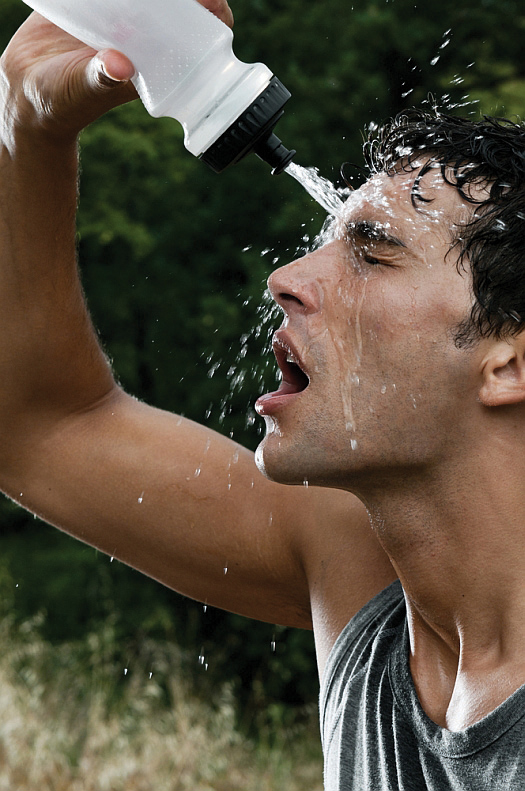This is “Nutrients Important to Fluid and Electrolyte Balance”, chapter 7 from the book An Introduction to Nutrition (v. 1.0). For details on it (including licensing), click here.
For more information on the source of this book, or why it is available for free, please see the project's home page. You can browse or download additional books there. To download a .zip file containing this book to use offline, simply click here.
Chapter 7 Nutrients Important to Fluid and Electrolyte Balance
Big Idea
Heed your thirst and drink up, but drink mostly water.
Video 7.1
Sport Safety: Dehydration
(click to see video)Dr. Casa, researcher and professor at the University of Connecticut, explains the importance of keeping hydrated during sports.

© Shutterstock
Maintaining the right level of water in your body is crucial to survival, as either too little or too much water in your body will result in less-than-optimal functioning. One mechanism to help ensure the body maintains water balance is thirst. Thirst is the result of your body’s physiology telling your brain to initiate the thought to take a drink. Sensory proteins detect when your mouth is dry, your blood volume too low, or blood electrolyte concentrations too high and send signals to the brain stimulating the conscious feeling to drink.
In the summer of 1965, the assistant football coach of the University of Florida Gators requested scientists affiliated with the university study why the withering heat of Florida caused so many heat-related illnesses in football players and provide a solution to increase athletic performance and recovery post-training or game. The discovery was that inadequate replenishment of fluids, carbohydrates, and electrolytes was the reason for the “wilting” of their football players. Based on their research, the scientists concocted a drink for the football players containing water, carbohydrates, and electrolytes and called it “Gatorade.” In the next football season the Gators were nine and two and won the Orange Bowl. The Gators’ success launched the sports-drink industry, which is now a multibillion-dollar industry that is still dominated by Gatorade.
The latest National Health and Nutrition Examination Survey, covering the period from 2005 to 2008, reports that about 50 percent of Americans consume sugary drinks daily.Ogden, C. et al. “Consumption of Sugar Drinks in the United States, 2005–2008.” Centers for Disease Control and Prevention. NCHS Data Brief, no. 71 (August 2011). http://www.cdc.gov/nchs/data/databriefs/db71.htm. Excess consumption of sugary soft drinks have been scientifically proven to increase the risk for dental caries, obesity, Type 2 diabetes, and cardiovascular disease. In addition to sugary soft drinks, beverages containing added sugars include fruit drinks, sports drinks, energy drinks and sweetened bottled waters. In Chapter 4 "Carbohydrates" we considered in detail the effects of sugary soft drinks on health. In this chapter we will consider sports drinks. Sports drinks are designed to rehydrate the body after excessive fluid depletion. Electrolytes in particular promote normal rehydration to prevent fatigue during physical exertion. Are they a good choice for achieving the recommended fluid intake? Are they performance and endurance enhancers like they claim? Who should drink them?
Typically, eight ounces of a sports drink provides between fifty and eighty calories and 14 to 17 grams of carbohydrate, mostly in the form of simple sugars. Sodium and potassium are the most commonly included electrolytes in sports drinks, with the levels of these in sports drinks being highly variable. The American College of Sports Medicine says a sports drink should contain 125 milligrams of sodium per 8 ounces as it is helpful in replenishing some of the sodium lost in sweat and promotes fluid uptake in the small intestine, improving hydration.
You Decide
Are there better beverage options than sugary soft drinks and sports drinks to satisfy your thirst?
In this chapter we will consider the importance of maintaining fluid and electrolyte balance in the human body, the functions of water and electrolytes in the body, the consequences of getting too much or too little of water and electrolytes, the best dietary sources of these nutrients, and healthier beverage choices. After reading this chapter you will know what to look for in sports drinks and will be able to select the best products to keep hydrated.
Video 7.2
Effects of Dehydration on Athletes
(click to see video)This video portrays the effects of hard-core training on the ability of an athlete’s body to adapt to extremes.
“We endorse thirst as the best scientifically supported method for you to use.”
Association of International Marathons and Distance Races




